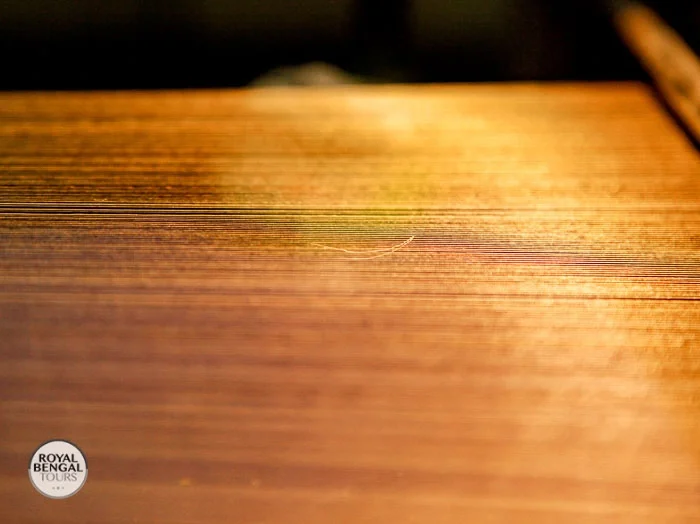Diverse faiths and shared culture
Archaeological sites of Bangladesh
Archaeological sites are impressive and scattered all over Bangladesh. North Bengal is a fascinating world of archaeological sites in Bangladesh. Tangail, Sirajgonj, Puthia, Rajshahi, Gaur, Paharpur, Bogra, and Dinajpur are home to the majority of the most renowned archaeological sites. This region unveils a rich tapestry of historical monuments, including a number of mosques, temples, stupas, rajbaris (land lord's palaces), British-era buildings, stunning landscapes, a rural lifestyle, delicious mango and litchi, silk, rivers, chars, and vibrant local and tribal culture.


In the northern part of Bangladesh, you will still find ruins of the highest Buddhist stupa south of the Himalayas in Paharpur, the Pundravardhana now known as Mahasthangarh – the first Hindu capital of Bengal, important Hindu structures in Puthia, terracotta Kantajee temple in Dinajpur. There are many Islamic architectural relics in the country in the form of mosques, madrasahs, palaces and mausoleums.
Buddhism in Bangladesh
Buddhism is one of the three major religions in Bangladesh; today, it has about one million followers, concentrated mainly in the southeastern region. The exact date of Buddhism’s arrival in Bengal is not known, but common belief dictates that the religion was firmly established during the reign of Emperor Asoka, who ruled from 273 to 232 BC. magnificent monasteries, temples and stupas were erected in many parts of the country.
Visitors, like the Chinese pilgrims who recorded their impressions of Bangladesh between the 5th and 7th century AD, spoke of the flourishing religion and mighty monuments even in remote areas. However, only a handful of those stupas and monasteries still exist today. The spread of Buddhism owed much to the kings of Bengal. Important royal dynasties, like the Palas (8th – 12th century AD), the Chandtas (10th – 11th century AD), the Devas and the minor ruling chiefs and Pattikara (11th – 13th century AD) offered their patronage and protection to the religion. A number of these monasteries were known to the far ends of the Buddhist world, and they are mentioned in the writings of Chinese and Buddhist pilgrims. The Viharas and other Buddhist places have been carefully preserved and a visit to them will acquaint you with the glorious past of Buddhism and the significance of Gautam’s preaching in Bangladesh.
Bogra Mahasthangarh
Mahasthangarh is standing over the graveyard of the ruins of ancient “Pundravardhana”- only a few kilometers away from Bogra town. It is the oldest known city in Bangladesh as the first Hindu capital of ancient Bengal, dating back to at least the 3rd century BC, located only 14 km north of Bogra town.
Mahasthan archaeological site consists mainly of foundations and hillocks hinting at the past glory. This region was not only the religious center for Hindus, Buddhists, or Muslims but also was an important commercial entrepot of the silk trade, which is only a few kilometers away from Bogra. The site Museum is worth visiting and has an interesting collection of recovered pieces on display. Statues of Hindu Gods, terracotta plaques, and some bronze statues; mostly found during the excavation of this monastery from the Pala period; are the highlights of this museum.

Vasu Bihar
The traveler Xuen Zhang wrote that this site accommodated 700 Buddhist monks in its monasteries back in the day. The remains of the temple and monasteries are the brickwork foundation of the complex, which consists of five mounds. This was a spot where the last Buddha had taken exercise and rested and traces of his footmarks are still to be seen. Vasu Bihar is located about 15km northwest of the Mahasthangarh site through the straight side road by the Museum.

Natore Rajbari and Uttara Gana Bhavan
Natore – is a small town, about an hour from Rajshahi or one and a half hours’ driveway from Bogra. Elegant Natore Rajbari with its fanciful gardens and temple-hemmed ponds, and the government building called Natore Raj Bari with its fanciful gardens and temple-hemmed ponds, and the government building called Uttara Gano Bhaban, previously known as Dighapatia Palace. Once it was the palace of Maharaja of Dighapatia, the region’s governor. And now it serves as an official residence of the president. The beautifully maintained complex occupies about 15 hectares of land. The magnificent Natore Rajbari is a series of seven Rajbaris, four of which remain largely intact.

Puthia Rajbari, Temples and Museum
Puthia – is known as a beautiful Hindu temple town, located about 16 km west of Natore and 23km eastern direction from Rajshahi just beside the Natore – Rajshahi Highway. Puthia has the largest number of historically important superb Hindu structures in Bangladesh and is one of the country’s finest old Rajbaris. The Shiva Temple is the largest Hindu temple in Bangladesh, while the Govinda Temple in the Rajbari courtyard is decorated with intricate terracotta designs.


Rajshahi
The prosperous university town is famous for its sericulture (silk production). Rajshahi grows almost half of the country’s famous mangoes, litchis and the only silk industry of the country. Strolling along the mighty Padma (Ganges) River and watching the sunset is a favorite pastime of residents and visitors. A block southeast of Rajshahi Government College, on a high bank of Padma River, is one of the last remaining examples of the Indigo Factories (Neel Kuthi) that once flourished in the region, this historic structure is known as Baro Kuthi. The place has apparently been the reminder of countless crimes during British rule. Apart from these, you will still find quite a number of buildings in Rajshahi town from the Raj era period, now converted into colleges and schools.

Varendra Research Museum
The oldest (1910) and has a huge collection of rare black basalt sculptures. The predominantly British-style building has some interesting Hindu-Buddhist features. The museum has artifacts from all over the subcontinent, including some rare examples from the ancient city of Mohenjo-Daro in Pakistan and a great collection of local Hindu sculptures. Martyr’s Memorial Museum in Rajshahi University is a reminder of the dreadful days of the liberation war. Among many things, there are also the deed papers of surrender by Pakistani forces.
Varendra Research Museum visiting hours
Summer Schedule: April to September
Saturday to Wednesday: 10:00 AM to 5:00 PM
Winter Schedule: October to March
Saturday to Wednesday: 10:00 AM to 4:30 PM
Ramadan Schedule: 10:00 AM to 4:00 PM (Ramadan visiting hours may vary depending on which season Ramadan falls in)
Thursday and Friday are weekends, and the museum is also closed on Rajshahi University-designated holidays.
Varendra Research Museum Ticket Fees
|
Nationality |
Ticket Price |
|
Students (Bangladeshi) up to the secondary level |
5.00 taka |
|
Bangladeshi |
20.00 Taka |
|
Visitors from SAARC member countries |
100.00 Taka |
|
And any other foreign nationalities |
200.00 Taka |
No entry fee is required for disabled persons and children under three years.
The South Asian Association for Regional Cooperation (SAARC) has eight member countries (Afghanistan, Bangladesh, Bhutan, India, the Maldives, Nepal, Pakistan, and Sri Lanka).
Dos and don’ts inside the Varendra Research Museum
- Do not touch any display items inside or outside the museum!
- Eating, smoking, spitting, photographing, and speaking on mobile phones are strictly prohibited.
- The visitor must keep their entry ticket until their visit is finished.
- A ticket will be valid for the date it was issued and can’t be transferred to another person or any other day.
- The entry ticket sales counter will be closed at least 30 minutes before the museum closing time.
Chapai Nawabgonj
The former capital of Sena has turned into a town of Mango and Nakshikantha – a hand-embroidered traditional quilt and a site of great historical importance. Chapai Nawabgonj also known as Gaur or Goud, has more mosques than any area of Bangladesh after Bagerhaat. Located about 100km west of Rajshahi town, on the western border of Bangladesh and some in India. The superbly decorated Chhota Sona Mosque (Small Golden Mosque) was built between 1493 and 1526. This is one of the main historical mosques in this area, which is very well preserved and still in daily use. This fine specimen of pre-Mughal architecture is actually a jet black with patches of terracotta brickwork. The chief attraction of the superb decoration is carved on the black-stone walls, both on the inner and the outer sides. May, June and July are the honey months in this area because of pick mango season. Every variety of mangoes are harvested from the little orchards throughout the district. This area becomes a lively vein of market activity over the season. Dispute Bangladeshi mango could not reach the International markets, probably due to dominating recognition of Pakistani, Indian and South American Mangoes. One should try Bangladeshi Amrupali, Himshagor, Lengra, Gopalvog, and Harivanga to tell the world what a mango should taste like!

Somapuri Vihara at Paharpur is UNESCO declared World Heritage Site
Paharpur: The UNESCO declared World Heritage Site Somapuri Vihara at Paharpur is the largest Buddhist monastery in the south of the Himalayas, dating from the 8th century AD. It is considered the most impressive and important archaeological site in Bangladesh. It is in the shape of a large quadrangle covering 11 hectares, with 377 monks’ cells making up the walls and enclosing a courtyard. The 20m high remains of a stupa rise from the center of the courtyard. Paharpur village is located in Jaipurhat.

Dinajpur
Dinajpur is predominantly a Hindu region, which is now shared by Bangladesh and India both. Some parts of Dinajpur area remained within the Indian state during the religion-based separation in 1947. Therefore, many locals have relatives, friends and families on either side, once in a while family meeting is a necessity and that can be another chapter of difficulties because of not having diplomatic knowledge or proper travel documents of poor Bangladeshi locals of this area. Around the Bangladesh – India border area reported and unreported killings of Bangladeshis by Indian soldiers, is quite an often case. Dinajpur of Bangladesh still has many historical architectures of religious importance, 18th century Rajbari with its adjoining Krishna temple is one of the most picturesque historic buildings in North Bengal. It is located about 4 km northeast of city central. Famous Kantajee Temple (also known as Kantanagar Temple) is the most spectacular Hindu temple and one of the most beautiful monuments in the country. Decorated with infinite panels of intricately sculpted terracotta plaques, this is the county’s finest example of terracotta and ancient bricks architecture. some of the locals believe that this temple was built by the god himself due to its complicated and finest terracotta decoration which is not possible to rebuild anymore. It was built in 1752 by Pran Nath, a renowned maharaja of Dinajpur. Ramshagor – the largest man-made pond surrounded by a beautiful greenery public park invites visitors from far and near. Huge numbers of migratory birds find their home at Ramsagar National Park.

Rangpur
Rangpur is home to the Kochi ethnic group and several public buildings of the Raj era, including the Carmichael College and Tajhat Palace. Kochi Ethnic people are an Indo-Tibetan race related to the plains tribes of Assam. Tajhat Palace is one of the finest Rajbaris in Bangladesh, the outlook is quite similar to Ahsan Manzil of Dhaka. Between 1982-1991 this palace was used by the High Court Division of Bangladesh Supreme Court. This superb palace has been converted into a museum recently with old manuscripts and findings from Paharpur and Mahasthangarh. Carmichael College is one of the largest educational institutes in the country in terms of both area and student enrolment. Situated on the outskirts of the town, the college was established in 1916. This brick building also looks similar to the Curzon Hall of Dhaka University with a frontage of about 100m, a great fusion of classical British and Mughal combination architecture.

Char or shifting River Islands of Bangladesh
Chars are the shifting river islands built from river erosion and sedimentation, which may disappear the same way again. The sandy islands and low-lying flood-prone areas at the river’s edge that are deposited, eroded, and re-deposited by the River tide, are known as CHAR.

The Bengal delta is a great horseshoe shape, flat, low-lying floodplain land, the open part is facing the Bay of Bengal to the south. The north and eastern edges are fenced by detached hill networks, out of this region flow some of the major rivers in southern Asia—the Ganges, the Brahmaputra, and the Meghna.
Proceeding their way slowly through the delta’s flat midsection, these rivers and their streams deposit huge loads of sand and soil, which over eras have slowly building up the delta’s land area, pushing its southern boundary to the ever-deeper Bay of Bengal. Newly formed lands in some area increase the mainland toward the waterbody, and in some area, the sedimentation happens within the river surrounded by the water all around, which is called “CHAR”. The rivers have always been natural veins of communication and transportation. Approximately 4 million people inhabit the Char, with around one million people actually living on island char, they are surrounded by water for most of the year. People living on these islands include some of Bangladeshi’s poorest. Erosion and annual flooding force thousands of households to move each year between the chars of Jamuna (Brahmaputra) River. Some of these households shift five to seven times in a single generation. Furthermore, the chars are mostly isolated from major markets with significant amount of time and money being spent by their residents to reach the mainland. The vast majority of char households are not covered by standard government services including health, education and police protection, rate of illiteracy and child marriage are very high in the char villages. Some NGO efforts for elementary education has slowly started to lightning the lives on some of the chars. Interaction between char dwellers and the private sector is also weak as transport costs are high and the chars are not connected to the national electricity grid. Seasonal agriculture and fishing are the main way of living for the char inhabitants. A daylong country boat trip through any of the char village would be a high recommendation to feel the richness of primitive life around.
Infamous Indigo Kuthis of British East India Company in Bangladesh
Indigo trade in the 18th and early 19th centuries: the plant that yields the indigo hue for dyeing – was the rage in Bengal. More than 150 indigo Kuthis (factories) were in the Rajshahi region by the mid-18th century. In order to plant more Indigo, the local zamindars (Land Lords) even loaned money to local farmhands. The kuthis were numerous and trade was so lucrative that labourers had to be imported to keep up the production and meet the market demands.


Unfortunately, the farmers did not profit from the trade for many reasons and high-interest rates of loans was one of the main. Compared to the rates commanded in the European market the peasants were paid a pittance for their crops. When any farmer tried to change crops, had to face some brutalities, torture and oppression of angry zamindars, terrorise farmers to continue with the indigo production, committing murder and burning whole villages were the extreme scenarios of that period. ‘No indigo box was dispatched to England without being smeared in human blood’- was the saying at that time.
Non-violent Indigo revolt happened in 1859. The revolution lasted two years and brought the indigo cultivation to a halt. Eventually, no other choice had remained for the government but to decree that the farmers could no longer be forced to plant indigo. The indigo trade had completely disappeared by the end of the century – as a result. Only a few of the kuthis were converted into silk factories, but most simply fell into ruin.
High on the riverbank in Rajshahi, although locked away behind gates and walls, Boro Kuthi is one of the last remaining examples of the indigo kuthis in this region. In the early 19th century Boro Kuthi was originally built by the Dutch as a silk factory, before being converted into an indigo kuthi by the British East India Company, it has also served as a fort during the times of emergency. After being on operation for around 25 years, this abandoned building subsequently has fallen into disrepair.

















